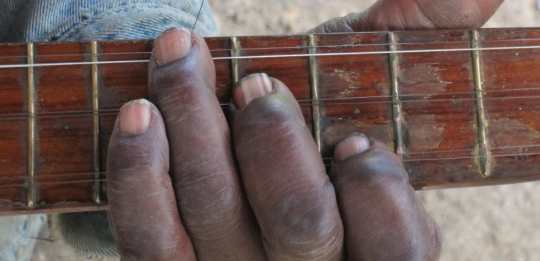|
There's a good argument to be made for this collection’s place as one of the more revelatory recordings of Cuban roots music ever released to western audiences. The sheer amount of documentation is part of that argument. Yet, aside from several commercial releases by one of the groups featured here, Grupo Changüi De Guantanamo, and some stray tracks on a few Rounder or Folkways collections, there hasn’t been a release that takes such a deep dive into a musical style that has existed for well over 100 years.
The Guantanamo region is in the extreme eastern corner of the island, and is isolated from the much of the world, even by Cuban standards. 50 miles from Haiti and covered in rainforest in the north and semi-desert in the south, its culture takes on elements of some of its Caribbean neighbors. It’s also the place where the tres- a guitar-like instrument heard in a number of different Cuban musical genres- was developed.

|
|
What sets changüi apart from the more familiar son, is the absence of the West African-derived clave rhythm. In changüi, the tres is buoyed by a cylindrical metal scraper and punctuated by hand drumming that often sounds like the lead instrument. The riffs of the tres drive the tunes, and vocals, like so many African-based musics, lean heavily on call and response. But more importantly, changüi is a party, a weekend-long, multi-ensemble-driven rum-soaked music and dance scene that begins every Friday, when the work week is over, and only ends Monday morning in time to go back into fields.

|
|
It was these gatherings, found all over the region, that journalist and music fanatic Gianluca Tramotana visited with his Zoom recorder and a few microphones over a two year period running from 2017 to 2019. What he came away with were stories, photos of changüi parties and the musicians who play them, artist bios and information about the songs. He also produced enough field recordings to fill 3 CDs, and it is the sounds he documented live in the streets and forests that make this collection so amazing. The music is of such consistently high quality that singling out particular performances seems pointless. However, of particular note are Las Flores Del Changüi, the only all-female ensemble on this collection. There are also two tracks by the 91 year-old Armando “Yu” Rey Leliebre, a man who lived in remote jungle outside of Felicidad. He performed solo on a tres that was especially rustic and sadly died not long after these recordings were made.

|
|
The musicians here lived in what we might refer to as shacks, where as late as the 1980s, electricity was scarce. Surrounding many of these towns are sugar cane fields, mountains, and lush rainforest. Yet places like Baracoa and Guantanamo City are as much the heart of Cuban life and music as anything in Havana. Changüi happens on the outskirts of any town, where the roads still often turn to dust. No matter, you can trace the roots of any produced, slick pop star out of Havana all the way to Guantanamo and changüi.
What Tramotana has accomplished has, on one hand allowed the rest of us to hear what is arguably the most-infectious music to come from the island, unproduced, recorded in its natural environment instead of having ensembles set up just for him in a studio. It shows a style that leaves room for improvisation, lyrically and musically, in a setting where songs go on as long as people are dancing. He has also allowed us to think of something besides the US-controlled Guantanamo Bay torture chamber for innocent Muslims from Central Asia and the Middle East, a place that remains as one of the darker symbols of failed US policy as the unpopularly-elected Bush administration declared war on an emotion after the events of 9/11. Instead, we now know the region as a place rich in culture, something that has long fed the people who live there, as well as the rest of the island. - Bruce Miller
|
